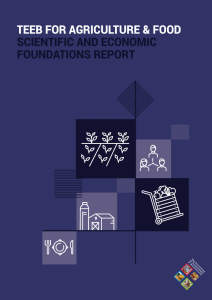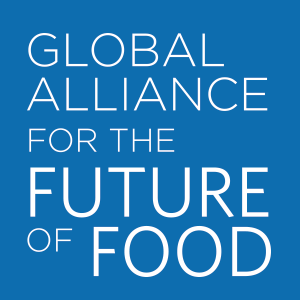 The TEEBAgriFood ‘Scientific and Economic Foundations’ report addresses the core theoretical issues and controversies underpinning the evaluation of the nexus between the agri-food sector, biodiversity and ecosystem services and externalities including human health impacts from agriculture on a global scale. It argues the need for a 'systems thinking' approach, draws out issues related to health, nutrition, equity and livelihoods, presents a Framework for evaluation and describes how it can be applied, and identifies theories and pathways for transformational change.
The TEEBAgriFood ‘Scientific and Economic Foundations’ report addresses the core theoretical issues and controversies underpinning the evaluation of the nexus between the agri-food sector, biodiversity and ecosystem services and externalities including human health impacts from agriculture on a global scale. It argues the need for a 'systems thinking' approach, draws out issues related to health, nutrition, equity and livelihoods, presents a Framework for evaluation and describes how it can be applied, and identifies theories and pathways for transformational change.
The report was launched on the occasion of World Environment Day in New Delhi, India. Read more
Download Full Report (English) - PDF
ISBN: 978-92-807-3702-8
Suggested citation: The Economics of Ecosystems and Biodiversity (TEEB) (2018). TEEB for Agriculture & Food: Scientific and Economic Foundations. Geneva: UN Environment.
Chapter summaries
1. TEEB for Agriculture & Food: background & objectives
Chapter 1 introduces ‘The Economics of Ecosystems and Biodiversity for Agriculture and Food’ (TEEBAgriFood) and its mission statement, within the context of the wider TEEB initiative. It highlights the need to fix food metrics by applying a holistic systems approach and evaluating the impacts and dependencies between natural systems, human systems and agriculture and food systems. Further, it explores the rationale and objectives of the Scientific and Economic Foundations report based on the extent of positive and negative externalities in ‘eco-agri-food systems’ and the lack of a coherent, universal framework, thus setting up the narrative and outline for the rest of the report.
2. Systems thinking: an approach for understanding eco-agri-food systems
Chapter 2 makes the case for using systems thinking as a guiding perspective for TEEBAgriFood’s development of a comprehensive Evaluation Framework for the eco-agri-food system. Many dimensions of the eco-agri-food system create complex analytical and policy challenges. Systems thinking allows better understanding and forecasting the outcomes of policy decisions by illuminating how the components of a system are interconnected with one another and how the drivers of change are determined and impacted by feedback loops, delays and non-linear relationships. To establish the building blocks of a theory of change, systems thinking empowers us to move beyond technical analysis and decision-tool toward more integrated approaches that can aid in the forming of a common ground for cultural changes.
3. Eco-agri-food systems: today’s realities and tomorrow’s challenges
Chapter 3 provides an overview of the diversity of agriculture and food systems, each with different contributions to global food security, impacts on the natural resource base and ways of working through food system supply chains. We describe “eco-agri-food systems” and further identify their many manifestations through a review of typologies. We identify challenges ahead with existing systems due to prevailing economic and political pressures resulting in patterns of invisible flows and impacts across global food systems. We describe pathways to ensure sustainability by securing the benefits from working with, rather than against, natural systems and ecosystem processes and the challenges for farmers, communities and societies to reorient food value chains and build resilience in eco-agri-food systems.
4. Human health, diets and nutrition: missing links in eco-agri-food systems
Chapter 4 outlines ways in which the food system impacts human health - directly or indirectly, negatively or positively – as well as food and nutritional security. It is illustrated how human health is compromised throughout our current food system both for end-point consumers and for those working along the supply chain. This chapter explores a number of endpoints in various food system strategies and creates a context for exploration, mitigation, change, and ultimately transformation of our global food system to one in which health – of humans, ecosystems, and communities – is the norm. We also illustrate ways in which various trends (e.g. climate change, fresh water, demographic shifts) alter the challenge of improving human health via food system activities.
5. Social equity, justice and ethics: missing links in eco-agri-food systems
Chapter 5 explores the impact of food systems on key aspects of social equity and justice, addressing particular ethical considerations related to hunger, sustainability, human rights, safety, marketing, trade, corporations, diets and animal welfare among others. The chapter identifies key components of food systems to promote equity from production to consumption, to food waste management. In an equitable food system, everyone has access to healthy food and the benefits and burdens of the food system are equitably distributed. These require policies that ensure poor people’s access to land, natural resources, technologies, markets, rights and gender equality. The chapter concludes that social equity, justice and ethical considerations should be fundamental values of our food system and the Sustainable Development Goals (SDGs).
6. The TEEBAgriFood Framework: towards comprehensive evaluation of eco-agri-food systems
Chapter 6 presents the TEEBAgriFood Evaluation Framework. The Framework establishes “what should be evaluated” and represents the next generation in assessment tools for eco-agri-food systems. It supports the assessment of different eco-agri-food systems, covering their human, social, economic, and environmental dimensions, from production through to consumption. The common, production-only, focus of assessment, using for example metrics of yield per hectare, ignores the significant range of social and environmental impacts that must be included for a complete evaluation. The Framework applies a multiple-capitals based approach, and supports the use of monetary and non-monetary approaches to impact assessment, including value addition. As a comprehensive and universal framework, it highlights all relevant dimensions, and drives policymakers, researchers, and businesses to broaden their information set for decision-making.
7. TEEBAgriFood methodology: an overview of evaluation and valuation methods and tools
Chapter 7 presents an overview of available evaluation and valuation methods and tools relevant to the analysis of dependence and impacts of various agricultural and food systems on human wellbeing. The market and nonmarket valuation tools and methods address to varying degrees the positive and negative externalities along the value chain of eco-agri-food systems. However, challenges emerge from the complexity of the systems, stemming from the temporal and spatial dimensions and management practices and value attribution across multiple ecosystem services. As decision making requires integration of economic values with other social and economic dimensions, the chapter presents an integrated systems approach, which helps in incorporating various dimensions together to evaluate the impact of various policies on human wellbeing.
8. Application of the TEEBAgriFood Framework: case studies for decision-makers
Chapter 8 demonstrates an initial exploration of the TEEBAgriFood Evaluation Framework through ten existing case studies that focus on various aspects of the value chain: agricultural management systems, business analysis, dietary comparison, policy evaluation and national accounts for the agriculture and food sector. Various issues within the Framework are explored, including the need for future modifications and adaptations. The case studies have helped identify opportunities to both expand particular aspects of the Framework for comparisons as well as to introduce spatial and temporal contexts. The explorations within this chapter are an introduction to a process that will continue to expand, as lessons are learned with each application of the Framework.
9. The TEEBAgriFood theory of change: from information to action
Chapter 9 shows how adopting the TEEBAgriFood Evaluation Framework can bridge the gap between knowledge and action. Factors that block the absorption of externalities in food systems, including path dependency and counternarratives regarding healthy diets, lead us to derive lessons for transformational change reflecting the critical role of power relations. Experience in agri-food certification and multi-stakeholder roundtables bespeak the need to address change from the starting point of key actors and relevant groups, including farmers, government, industry and consumers. Successful change in food systems to reflect invisible values can be enabled by identifying specific action roles through partnerships and alliances as well as multilateral agreements including the SDGs.
10. TEEBAgriFood and the sustainability landscape: linking to the SDGs and other engagement strategies
Chapter 10 applies TEEBAgriFood’s Theory of Change to develop specific engagement strategies for TEEBAgriFood. Transformations of the eco-agri-food system depend on alliances for change. Therefore, the chapter situates TEEBAgriFood in the normative framework provided by the Right to Food and relates it to other valuation initiatives. The chapter emphasizes TEEBAgriFood’s contribution to the integrated implementation of the 2030 Agenda. By identifying and mapping the positive and negative externalities of specific eco-agri-food system measures, TEEBAgriFood identifies synergies and trade-offs between the SDGs. Proceeding like this, TEEBAgriFood supports follow up and review of the 2030 Agenda. Overall, the chapter emphasizes the benefits from a strategic application of TEEBAgriFood insights for eco-agri-food system transformation.
See also
- Synthesis Report (in six languages)
- Report Artwork
- Slideshow Presentation
- Promotional Toolkit
- Social Media Toolkit

